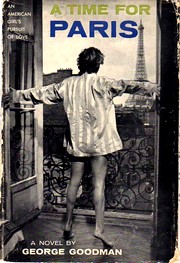 Marshmallows have more substance than this book. Stalwart Yale-grad and Korean War vet Fred Holland sails off to serve in the American Embassy in London. He and his chum spot pretty Sally White, also of good WASP stock, boarding their ocean liner. Fred chats up Sally, who turns out to be an old but distant acquaintance from summers on the island in Maine.
Marshmallows have more substance than this book. Stalwart Yale-grad and Korean War vet Fred Holland sails off to serve in the American Embassy in London. He and his chum spot pretty Sally White, also of good WASP stock, boarding their ocean liner. Fred chats up Sally, who turns out to be an old but distant acquaintance from summers on the island in Maine.
They flirt during the voyage and Fred accompanies Sally for a few days’ idyll in Paris before joining his post in London. Thanks to cheap flights and trains, they see each other occasionally over the next few months. Sally amuses herself with an avant-garde lover and then one of Fred’s old Army buddies. Fred establishes himself as a sturdy right-hand man to one of the Foreign Service’s rising stars. Fred and Sally wonder to themselves: is this love? Is this friendship? Is this a mistake?
Despite detours into romances with an English earl (Sally) and a worldly older woman (Fred), true love reigns in the end, with stalwart Fred flying an ailing Sally to a hospital, saving her life and winning her heart.
So why read this book? Isn’t this just a fancy variation on a Harlequin novel?
For me, the attractions of A Time for Paris are nostalgia and good, if ultralight, writing. Author George Goodman would later become much better known as Adam Smith, author of the best-selling The Money Game and host of a long-running PBS show. Goodman spent a year as a Rhodes scholar at Oxford, and he brings many of his impressions of England and France from that time into A Time for Paris.
In some ways, the world of A Time for Paris is as mannered and archaic as anything in Henry James: the schools one went to, the cut of one’s suit, the slant of one’s politics all still matter and are used like litmus tests by many of the characters. This is world where parties are still for drinking cocktails and smoking is obligatory. On the other hand, this is not quite your grandmother’s world. Both Fred and Sally have
Sexual liberation aside, though, the line between male and female is drawn in big, bold strokes. Though Sally runs to Europe to escape marriage to a conventional suburb-residing, daily-commuting, WASP male, by the end of the book she is destined to marry Fred, settle down to raise 2.5 children, and drive a station wagon, as we all know is only right and just.
Yes, it’s all out-dated, two-dimensional, and ridiculous. But fun. After all, even marshmallows deserve their spot on our kitchen shelves.

Thanks for the comment. It’s nice to hear that someone had a strong personal connection with the book. For myself, I can think of a few “marshmallow-ish” books that mean a lot more to me than much more substantial classics. MacDonald Harris’ “Mortal Leaps,” which I wrote about here years ago, is one of those. I’d love to see the paperback cover–does it compete with that great picture on the hardback dust jacket?
What a great –– and honest –– review of this book. I have the 1962 paperback, which for many years was my bible. Something about Sally’s
seeming independence, coupled with total dependence, resonated with me, a child of the ’40s. I wanted to be just like her…. and in some ways
was. But somehow my life never seemed as romantic. As I type this, my book lies before me, nearly every page torn from its binding. In
every way, a book well read. Thanx for the memories.
Thanks, Nathan. When I saw this cover, I knew I had to buy this book if the prose inside seemed even remotely worth reading. Fortunately, it was. The $2 price tag didn’t hurt, either.
Editor, keep up the great work – I find Neglected Books fascinating. You’re making a difference in the world, rememberig these books.
Just some of these covers (like this one) are fascinating social documents in themselves.
Thanks for the kind words. At times it seems as if these posts just go out into the ether and disappear, so it’s nice to get a pingback once in a while–and especially to hear that someone else was inspired to give one or more of these titles a try.
Just a note to say how much I enjoy your blog/web site. Keep up the good work. I have bought a number of your recommended books and will continue to do so. Your (p)reviews are spot on.
Thanks again. Your work is much appreciated.
Otey
Cheap flights and trains in 1957? Between London and Paris? That really is fiction!